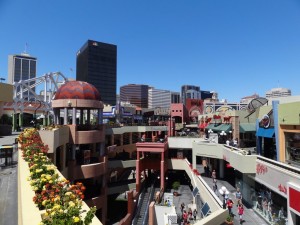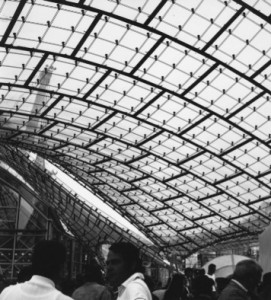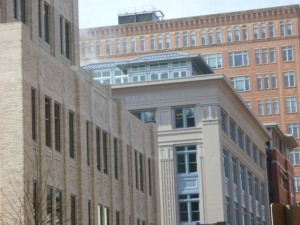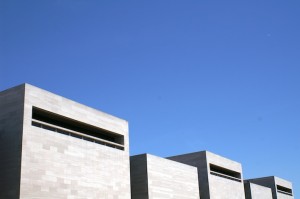MAKESHIFT METROPOLIS
by Witold | May 6, 2015 | Urbanism
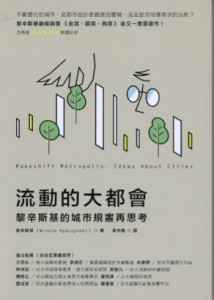 Owl Publishing House in Taipei has just issued a translation of Makeshift Metropolis: Ideas About Cities. The book has also been translated into Russian (Strelka Press, Moscow) and will soon be available from Commercial Press of Beijing. Translations of Home and One Good Turn are also available from Owl.
Owl Publishing House in Taipei has just issued a translation of Makeshift Metropolis: Ideas About Cities. The book has also been translated into Russian (Strelka Press, Moscow) and will soon be available from Commercial Press of Beijing. Translations of Home and One Good Turn are also available from Owl.
THE MILLE-FEUILLE EFFECT
by Witold | Mar 29, 2015 | Architecture, Modern life
Writing about the late Jon Jerde in a recent issue of Architect, Karrie Jacobs brought me up short with a wonderfully pithy phrase. She described a Jerde-designed project as “a mille-feuille of the simulated and the real, layer upon layer upon layer.” Exactly. I remember visiting the newly-built Horton Plaza in San Diego, an urban shopping mall that Jerde designed in 1985. My first reaction was revulsion—this was postmodernism on steroids, cliché piled upon cliché. But then the Mille-Feuille Effect kicked in. The stagey architecture was obviously fake, but the sun and fresh air were real (the public spaces were not roofed). The ersatz arches and polychromy were artificial, yet the views of downtown buildings were real enough—this was one mall that was was not hermetically sealed off from its surroundings. And of course the people who were clearly enjoying themselves in this architectural jungle gym were real, too.
THROUGH A GLASS DARKLY
by Witold | Mar 17, 2015 | Architecture
 I was interviewed recently by Gil Roth for his literary-cultural podcast, The Virtual Memories Show. At one point he asked me what I thought about the future of architecture. No one had ever posed that question directly to me before, and when I answered I realized—much to my surprise—that I was not sanguine about the prospect. It seems to me that several factors have come together to produce a perfect storm (sorry), upending this ancient art.
I was interviewed recently by Gil Roth for his literary-cultural podcast, The Virtual Memories Show. At one point he asked me what I thought about the future of architecture. No one had ever posed that question directly to me before, and when I answered I realized—much to my surprise—that I was not sanguine about the prospect. It seems to me that several factors have come together to produce a perfect storm (sorry), upending this ancient art.
Education, always a difficult undertaking in any creative field, has become divorced from practice. The lingering effect of so-called history-theory has not helped, nor has the technology of the Digital Age. The study of history was for long the foundation of learning to be an architect. Because architecture is not a science, there is no “theory of architecture” undergirding practice. Rather, there is the canon of built works, which provides continued inspiration—inspiration, not models. Turning away from the past today’s architects risk stranding themselves in the present—or worse, in the future. As for digital technology: ever since the Renaissance, architects used sketching, drawing, and model-making to explore architectural ideas, evolving a language of scales and graphic conventions to communicate their ideas—to themselves, and their clients. This language is in the process of disappearing. The result: we are making it up as we go along.
The effect of globalization on architectural practice cannot be understated. In the past, architectural fame was regional, in small countries it might be national; now it is worldwide. This raises the stakes considerably. “Getting the next job,” as H. H. Richardson observed, was always the architect’s greatest challenge. With globalization, the next job may come from anywhere in the world. Who could resist that? Of course, that has taken architects far afield, building in places and for people with whom they have no intimate connection. This does not necessarily produce better buildings.
An important side effect of globalization is the supremacy of the architect’s brand. Le Corbusier and Mies were well-known, but Renzo and Zaha are global brands. If you are an Azerbajani, say, and you have commissioned (at extra cost) a brand-name architect from halfway around the world, you expect a brand-name building. A splash. An event. This produces a troubling result. What used to distinguish buildings from other artifacts was that they were built to last hundreds of years. This resulted in a certain conservatism, less concern with the latest fashion (that was left to interior decorators) and more awareness of the long haul. Brand-name buildings are unveiled as if they were the latest models of cars, or dresses, or music videos. They are there to be immediately enjoyed, and by implication, will be disposed of when fashions change. What happens when buildings become as temporary as smart phones? The architect as a large-scale product designer is not a happy thought.
THE TENT MAN
by Witold | Mar 11, 2015 | Architects
Frei Otto (1925-2015) is an inspired choice for the Pritzker Prize. When I was a young architect, he was the man of the moment. I thought that his German pavilion at Montreal’s Expo ’67 was the best building of the exhibition. The sense of fluid, uncompartmented space created by the tent structure was something entirely new. That was just a warm-up for his breathtaking Olympic Stadium in Munich. I saw that building in 1972 and wrote about it—my second ever published article. Otto was later overshadowed by postmodernism, and by celebrity-driven architecture, but his lightweight architecture prepared the way for architects such as Piano, Foster, and Grimshaw. Otto—an engineer as well as an architect—never used structure as a fashion statement; his solutions were always rooted in iron-clad logic.
WORTH EVERY PENNY
by Witold | Mar 5, 2015 | Urbanism
Downtown Fort Worth is a lively urban place that includes a central plaza, shops and restaurants, movie houses, theaters, a concert hall, and a public library. At the head of Main Street is the 1895 Tarrant County Courthouse, which resembles the state capitol in Austin, but with a clock tower instead of a dome. The downtown architecture is a mixture of styles: the Renaissance Revival courthouse, Sullivanesque office blocks from the early 1900s, Art Deco buildings from the 1930s, and modern towers from the 1980s (notably two glass hulks by Paul Rudolph). Most of the commercial construction tracked recurring oil booms. “When we get some money we like to build,” Edward Bass tells me. Bass is the motive force behind Sundance Square, the development company that is responsible for the revival of Fort Worth. There are different models for successful downtown renewal: an activist civic leader (Mayor Joe Reilly in Charleston), a take-charge business improvement district (Center City District in Philadelphia), a thriving real-estate market (Washington, D.C.). In Fort Worth, it’s a benevolent developer. Sundance Square owns about 30 city blocks in downtown (currently about half built-up), and has been developing them since the mid 1980s. This sort of long-term stewardship is unusual. Bass had read Jane Jacobs and William H. Whyte, and he took their teaching to heart. The result is commercial development that is pedestrian-oriented, lively at sidewalk level, and—most unusual—small in size. “We wanted lots of buildings, not a few big buildings,” says Bass. The tallest new office building is 16 stories, and most are much lower than that. Unlike most American cities, which have “exciting” skylines, Fort Worth is more like a downtown of the 1940s—human scale. The architecture is like that, too. David M. Schwarz Architects is responsible for all Sundance Square’s commercial buildings, as well as the expanded central library, the new concert hall, and some of the county buildings. Normally that would produce mind-numbing uniformity, but Schwarz is a cheerful eclectic with a scenographic bent, so the result is a pragmatic mix of historic buildings, restored landmarks, invented landmarks, repurposed old buildings, and new buildings in a variety of styles: Beaux-Arts classical, Art Deco, Art Moderne, Viennese Secession. Schwarz has described his firm’s goal: “to make places for people, created out of a fabric that was familiar and easy to understand.” In Fort Worth, he succeeded.
THROWAWAY ARCHITECTURE
by Witold | Feb 15, 2015 | Architecture, Modern life
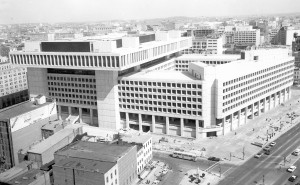 The federal government is looking for a developer to build a new suburban home for the FBI. The old FBI headquarters on Pennsylvania Avenue in Washington, DC is offered in exchange. A 41-year-old public building is going on the block. Admittedly the FBI headquarters (designed in 1975 by Charles F. Murphy & Associates) is an eyesore and won’t be missed (assuming it’s torn down, which seems to be its likely fate). But only 41 years! Washington is full of buildings that are two and three times as old. The first federal office building, the venerable Patent Office, designed by John Mills, opened in 1867 and still serves, albeit as an art gallery. I think that there are several reasons why so many public buildings from the 1970s have short lives. Architectural modernism promotes invention. An earlier generation would have built a generic loft building. Modernism required something more original, although the FBI building was inspired by Le Corbusier’s La Tourette Dominican priory—an odd model for a government office building. “Form follows function” is another reason for short life. Tailoring buildings for one use guarantees problems when they come to be repurposed in the future—as virtually all buildings are at some point. Concrete construction also doesn’t help, since it tends to create structures that are difficult to alter. And, not least, the ugly Brutalist style of the 1970s ensures that there will be no constituency militating for a building’s preservation (except for a few earnest architecture critics). What a waste.
The federal government is looking for a developer to build a new suburban home for the FBI. The old FBI headquarters on Pennsylvania Avenue in Washington, DC is offered in exchange. A 41-year-old public building is going on the block. Admittedly the FBI headquarters (designed in 1975 by Charles F. Murphy & Associates) is an eyesore and won’t be missed (assuming it’s torn down, which seems to be its likely fate). But only 41 years! Washington is full of buildings that are two and three times as old. The first federal office building, the venerable Patent Office, designed by John Mills, opened in 1867 and still serves, albeit as an art gallery. I think that there are several reasons why so many public buildings from the 1970s have short lives. Architectural modernism promotes invention. An earlier generation would have built a generic loft building. Modernism required something more original, although the FBI building was inspired by Le Corbusier’s La Tourette Dominican priory—an odd model for a government office building. “Form follows function” is another reason for short life. Tailoring buildings for one use guarantees problems when they come to be repurposed in the future—as virtually all buildings are at some point. Concrete construction also doesn’t help, since it tends to create structures that are difficult to alter. And, not least, the ugly Brutalist style of the 1970s ensures that there will be no constituency militating for a building’s preservation (except for a few earnest architecture critics). What a waste.
MIAMI NICE
by Witold | Feb 8, 2015 | Architecture
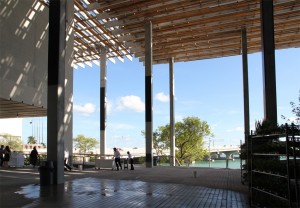 The Pérez Art Museum in Miami suits the city and it suits modern art. Can’t ask for more than that. My first glimpse of the museum, which opened in 2013, was from the MacArthur Causeway, which swoops across the water next to the museum. The hovering shade roof over a boxy building gave the impression of a Renzo Piano museum. But something was different, and the difference became clear when later that day we visited the building. As in a Piano building, the architecture is derived from the construction, but unlike Piano, Herzog and de Meuron don’t sweat the details. Instead of preciousness there is an appealing rough-and-ready quality. The concrete is smooth, but not silky smooth like the Kimbell; the roof shade, a slapped-up assembly of wood and concrete, is not delicate like that of the Chicago Institute of Art. All this suits Miami, a booming city of construction cranes (recession, what recession?) that is rebuilding itself decade by decade in an improvised and not particularly coherent way. The site of the museum is on the water (good), but it is also next to the MacArthur Causeway (bad). How do you build a cultural facility next to a reasonable approximation of the Indianapolis Speedway? The New York Times has described the Pérez Museum as “spectacular,” but that is not the right word. It is assertive and self-confident, but not theatrical. The planted columns that hang from the roof outside are photogenic but they strike me as weird rather than interesting. Their logic becomes apparent when you are inside looking out—they make an interesting green screen. And the discrete white galleries do not overwhelm the art, as far as I could tell (I am not a fan of contemporary art). A final word—about the parking garage. The museum is raised on a platform beneath which sits the garage. With a few deft strokes, the architects have transformed this arrival space (this is Miami so everyone drives). Natural light penetrates from the sides; tropical planting is mixed in among the parked cars; and the floor is not concrete but gravel. That feels rough-and-ready, too..
The Pérez Art Museum in Miami suits the city and it suits modern art. Can’t ask for more than that. My first glimpse of the museum, which opened in 2013, was from the MacArthur Causeway, which swoops across the water next to the museum. The hovering shade roof over a boxy building gave the impression of a Renzo Piano museum. But something was different, and the difference became clear when later that day we visited the building. As in a Piano building, the architecture is derived from the construction, but unlike Piano, Herzog and de Meuron don’t sweat the details. Instead of preciousness there is an appealing rough-and-ready quality. The concrete is smooth, but not silky smooth like the Kimbell; the roof shade, a slapped-up assembly of wood and concrete, is not delicate like that of the Chicago Institute of Art. All this suits Miami, a booming city of construction cranes (recession, what recession?) that is rebuilding itself decade by decade in an improvised and not particularly coherent way. The site of the museum is on the water (good), but it is also next to the MacArthur Causeway (bad). How do you build a cultural facility next to a reasonable approximation of the Indianapolis Speedway? The New York Times has described the Pérez Museum as “spectacular,” but that is not the right word. It is assertive and self-confident, but not theatrical. The planted columns that hang from the roof outside are photogenic but they strike me as weird rather than interesting. Their logic becomes apparent when you are inside looking out—they make an interesting green screen. And the discrete white galleries do not overwhelm the art, as far as I could tell (I am not a fan of contemporary art). A final word—about the parking garage. The museum is raised on a platform beneath which sits the garage. With a few deft strokes, the architects have transformed this arrival space (this is Miami so everyone drives). Natural light penetrates from the sides; tropical planting is mixed in among the parked cars; and the floor is not concrete but gravel. That feels rough-and-ready, too..
THE VIEW FROM ABOVE
by Witold | Feb 8, 2015 | Architecture
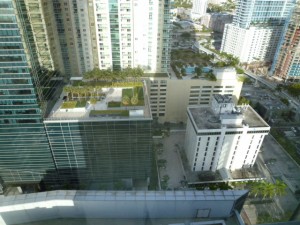 I’m staying in a Miami hotel, looking down on Brickell Avenue. Since I’m on the 29th floor, I can see the roofs of several lower buildings. Looking down on a building gives a different perspective of its architecture. From this vantage point, buildings that appear solid from the ground become insubstantial, theatrical, flimsy—the facade revealed as merely a wrapper. The wrapper stops at roof level, and the roof itself, invisible from below, is a utilitarian collection of cooling towers and other mechanical equipment. The building across the avenue is a recently completed office tower with ten-story annex whose roof is covered with a garden. Seen from above, a garden is still a garden, the swaying palms are still palms, the pavement pattern is still a pattern. This reminds me that much of architecture is a manufactured illusion—the magically hovering cantilever, the effortlessly sweeping roof, the glass handrail that almost isn’t there. Whereas landscape is always landscape.
I’m staying in a Miami hotel, looking down on Brickell Avenue. Since I’m on the 29th floor, I can see the roofs of several lower buildings. Looking down on a building gives a different perspective of its architecture. From this vantage point, buildings that appear solid from the ground become insubstantial, theatrical, flimsy—the facade revealed as merely a wrapper. The wrapper stops at roof level, and the roof itself, invisible from below, is a utilitarian collection of cooling towers and other mechanical equipment. The building across the avenue is a recently completed office tower with ten-story annex whose roof is covered with a garden. Seen from above, a garden is still a garden, the swaying palms are still palms, the pavement pattern is still a pattern. This reminds me that much of architecture is a manufactured illusion—the magically hovering cantilever, the effortlessly sweeping roof, the glass handrail that almost isn’t there. Whereas landscape is always landscape.
TRIED AND TRUE
by Witold | Jan 25, 2015 | Architecture
“Experimentation can sometimes look weird at first, but it is a necessary part of figuring out how to make our human-built world better,” writes Aaron Betsky in his December 2014 Architect column. The implicit suggestion is that architectural experimentation is a good and necessary thing. But buildings that “look weird” are one thing, buildings that act weird are another. Buildings, unlike most artifacts, must last a long time—hundreds of years—so in terms of construction, weirdness should be avoided. In the sixteenth century, the great Palladio built revolutionary buildings, but he did so using tried and true technology, which is why so many of his works have survived. On the other hand, the National Air and Space Museum in Washington, D.C., which is barely 40 years old, just announced that its facade will be “revitalized” as part of a $30 million renovation. When Gyo Obata of HOK designed the museum in 1976, he matched the Tennessee marble skin to the National Gallery across the Mall. But he didn’t match the way it was used. John Russell Pope, used marble that is 4-8 inches thick; the marble on the Air and Space Museum is only 1 1/4 inches thick. Over the years, the thin slabs have begun to bow and crack, and now have to be entirely replaced. The marble skin of I.M. Pei’s nearby East Building of the National Gallery (1978) also failed, although for a different reason: the stainless steel anchors of the marble skin had to be replaced and the entire marble wall rebuilt. There is nothing novel about architectural veneer; the ancient Romans covered the brick structure of the Pantheon with marble slabs, and a thousand years later Charles McKim used basically the same technology in the Morgan Library. The Romans, McKim, and Pope, used marble to build thick self-supporting walls that wrapped around the structure, while Pei and Obata hung the marble from the structure. No one would describe the East Building or the Air and Space Museum as weird, but their architects were experimenting in adopting untried construction methods. Of course, if you believe that today’s architects and engineers are simply smarter that those of forty years ago, you can be cavalier about innovation. But the unintended consequences that accompany new materials and novel techniques are difficult to predict precisely because they are unintended. Better to go slow.
A NEW TOOLKIT
by Witold | Dec 24, 2014 | Architecture
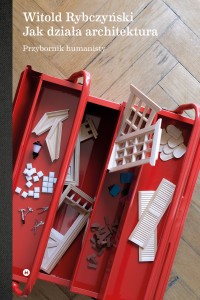 A Polish translation of How Architecture Works: A Humanist’s Toolkit will be appearing soon from Wydawnictwo Karakter in Krakow. Translations are also in the works from Owl Publishing House in Taipei, Cheers Media in Beijing, and CIR Co. in Seoul.
A Polish translation of How Architecture Works: A Humanist’s Toolkit will be appearing soon from Wydawnictwo Karakter in Krakow. Translations are also in the works from Owl Publishing House in Taipei, Cheers Media in Beijing, and CIR Co. in Seoul.
Polish speakers can read my interview in Gazeta Wyborcza.
THE LATEST


